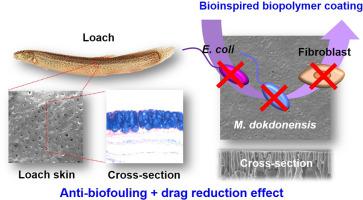Progress in Organic Coatings ( IF 6.6 ) Pub Date : 2021-06-17 , DOI: 10.1016/j.porgcoat.2021.106383 Eunseok Seo , Jiwon Park , Jung-Eun Gil , Heejin Lim , Dohoon Lee , Sang Joon Lee

|
Anti-biofouling surfaces are very important owing to their significant roles in microfluidic devices, biosensors and biomedical devices. However, traditional anti-biofouling surfaces could contaminate the environment. Thus, the development of environment-friendly coatings is an essential undertaking in efforts to resolve the problems associated with conventional anti-biofouling surfaces. Herein, a novel strategy inspired by the slippery surface of loach skin is proposed for the rational design of anti-biofouling surfaces. In this strategy, hydrophilic biopolymers, including chitosan, carboxymethyl cellulose, mPEG-amine (MW, 10,000 Da) and alginate, are grafted on a porous polycaprolactone (PCL) membrane. The porous PCL surface is a biomimetic surface inspired by the skin surface of a loach that secretes mucus. Previously developed antifouling surfaces were often toxic or the coating substances were easily released to the outside, and their drag reduction effects were not examined. The developed coating surface is not toxic and the coating material is not depleted to the outside. The resultant covalent biopolymer-coated surfaces (BCSs) exhibit excellent hydrophilic property and drag reduction effect in water. Especially, the additional coating of mPEG-amine on the alginate-coated surface exhibits the best drag reduction performance. In addition, the BCSs show superior anti-biofouling performance by resisting the adhesion of bacteria (Escherichia coli and Maribacter dokdonensis) and NIH3T3 fibroblasts. The proposed covalent biopolymer coatings could be potentially utilised as eco-friendly surfaces for drag reduction and anti-biofouling.
中文翻译:

受泥鳅皮启发的多功能生物聚合物涂层
由于其在微流体设备、生物传感器和生物医学设备中的重要作用,抗生物污垢表面非常重要。然而,传统的防生物污垢表面可能会污染环境。因此,开发环境友好型涂料是解决与传统防生物污损表面相关的问题的一项重要工作。在此,受泥鳅皮光滑表面启发,提出了一种新策略,用于合理设计抗生物污垢表面。在该策略中,亲水性生物聚合物,包括壳聚糖、羧甲基纤维素、mPEG-胺(MW,10,000 Da)和藻酸盐,接枝在多孔聚己内酯 (PCL) 膜上。多孔 PCL 表面是一种仿生表面,其灵感来自分泌粘液的泥鳅皮肤表面。以前开发的防污表面通常有毒或涂层物质容易释放到外面,并且没有检查它们的减阻效果。显影后的涂层表面无毒,涂层材料不会消耗到外部。所得共价生物聚合物涂层表面(BCS)在水中表现出优异的亲水性和减阻效果。特别是,在藻酸盐涂层表面上附加的 mPEG-胺涂层表现出最佳的减阻性能。此外,BCSs 通过抵抗细菌的粘附显示出优异的抗生物污染性能。显影后的涂层表面无毒,涂层材料不会消耗到外部。所得共价生物聚合物涂层表面(BCS)在水中表现出优异的亲水性和减阻效果。特别是,在藻酸盐涂层表面上附加的 mPEG-胺涂层表现出最佳的减阻性能。此外,BCSs 通过抵抗细菌的粘附显示出优异的抗生物污染性能。显影后的涂层表面无毒,涂层材料不会消耗到外部。所得共价生物聚合物涂层表面(BCS)在水中表现出优异的亲水性和减阻效果。特别是,在藻酸盐涂层表面上附加的 mPEG-胺涂层表现出最佳的减阻性能。此外,BCSs 通过抵抗细菌的粘附显示出优异的抗生物污染性能。大肠杆菌和Maribacter dokdonensis ) 和 NIH3T3 成纤维细胞。所提出的共价生物聚合物涂层有可能用作减阻和抗生物污垢的环保表面。


























 京公网安备 11010802027423号
京公网安备 11010802027423号